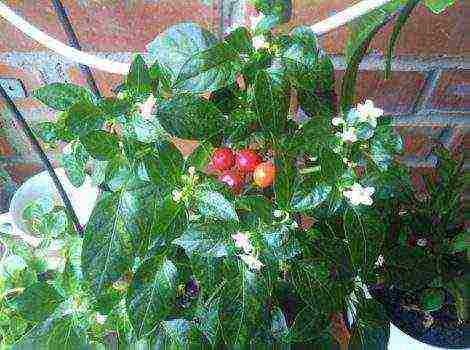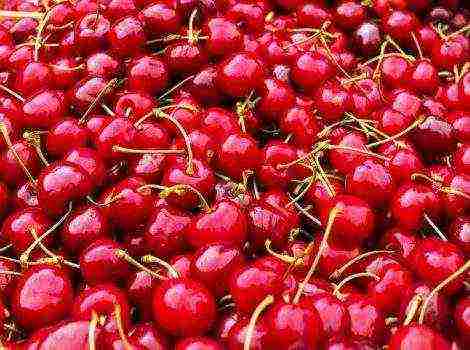Content
- 1 The best determinant tomato varieties for greenhouses in Siberia
- 2 The best fruitful sweet varieties for the Urals
- 3 What are the early varieties of tomatoes to plant in the greenhouse?
- 4 Highest Yielding Polycarbonate Greenhouse Tomatoes
- 5 Medium and late greenhouse varieties
- 6 Eagle heart
- 7 Koenigsberg
- 8 Abakan pink
- 9 Chio-chio-san
- 10 Apple tree of Russia
- 11 Monomakh's hat
- 12 Puzata khata
- 13 Golden domes
- 14 Eagle beak
- 15 De Barao
- 16 Bull heart
- 17 Selection factors
- 18 Review of the best varieties of tomatoes 2017-2018
- 19 Tomato varieties for greenhouses for different characteristics
- 20 Tomatoes for the greenhouse: the best varieties according to the reviews of gardeners in 2018
A polycarbonate greenhouse is the best option for growing tomatoes. It creates reliable protection against weather disasters and spring frosts, the honeycomb material maintains a favorable temperature regime for plants. This article provides an overview of the rules for selecting a tomato variety suitable for greenhouse cultivation. After reviewing the information, you will not need to determine the varieties of tomatoes by trial and error. It is better to trust the experience of selection, as well as specialists and noble gardeners.
The best determinant tomato varieties for greenhouses in Siberia
Bourgeois
A brief description of:
- medium early ripening;
- bush height 80-130 cm (in the southern regions up to 150 cm);
- growing season 100-110 days;
- the mass of rounded red fruits - 200-400 gr.;
- yield - 3 kg per bush.
The Bourgeois hybrid was bred by Ukrainian breeders, in 2004 it was registered in Russia. The variety is recommended for cultivation in the southern regions of the country and the middle lane. In the Urals and Siberia, it is more often planted in a closed greenhouse or greenhouse.
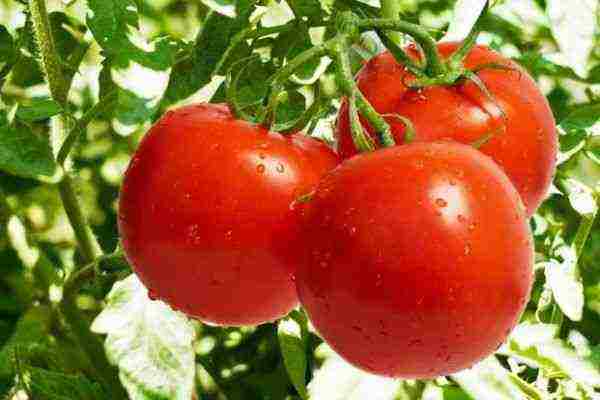 Tomato Bourgeois
Tomato Bourgeois
Bourgeois has a strong immunity, which explains the resistance to many diseases, easily tolerates temperature extremes, drought.
The only drawback is the low yield.
Openwork
A brief description of:
- medium early ripening;
- growing season - 100-110 days;
- plant growth - 60-90 cm;
- fruit weight - 240-280 g.;
- the shape of the tomato is round, slightly flattened;
- yield - up to 4 kg per bush.
The high-yielding determinant hybrid Azhur was bred by domestic breeders, was registered in 2007. The culture is recommended for cultivation in the Central regions of Russia, Krasnodar Territory, Astrakhan Region. In regions with a more severe climate (Krasnoyarsk Territory, Chelyabinsk Region), it is planted in a greenhouse.
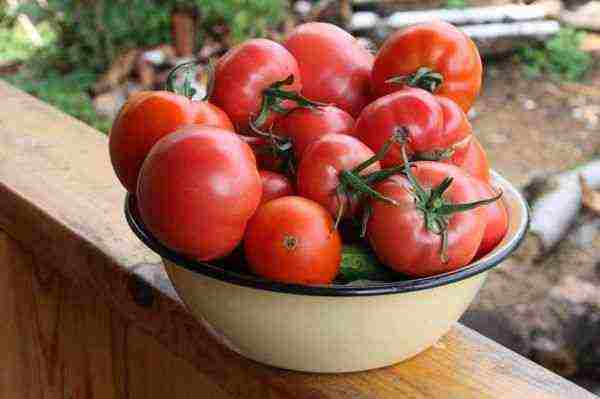 Tomatoes Openwork
Tomatoes Openwork
Advantages of the variety: resistance to diseases, pests, lack of moisture. Tomatoes have excellent taste, the use of fruits is universal. There are no significant shortcomings, rather the features of the culture, which consist in the mandatory formation of bushes and regular fertilization.
Honey cream
A brief description of:
- early ripening;
- growing season 90-100 days;
- bush growth - 60 cm;
- the mass of oval-shaped fruits - 60-70 gr.;
- yield - 4.2 kg per plant.
The honey cream variety is very tasty, sweet with a slight sourness. The skin of the fruit is dense, which allows the harvest to be stored for a long time. The culture has strong immunity, shows resistance to fungal and viral infections.
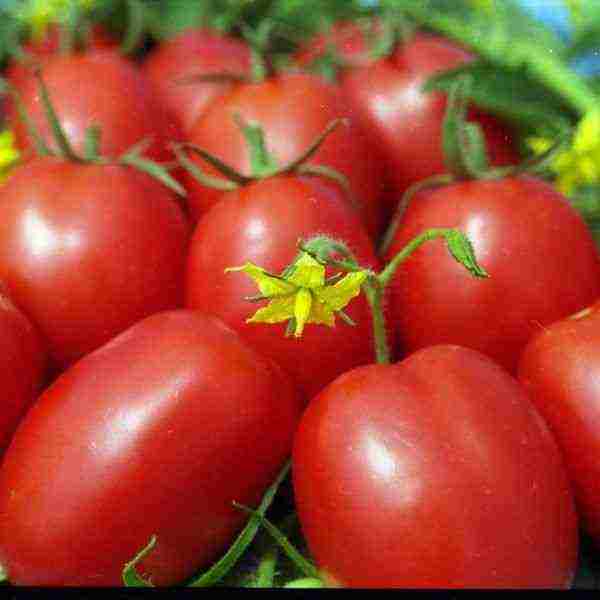 Honey cream
Honey cream
The variety is recommended for growing in the middle lane, in the south. In the northern regions of the country, planting is best done in a greenhouse.
Big Mama
A brief description of:
- early ripening;
- vegetation 85 days;
- bush height up to 60 cm;
- fruit weight - 200-400 gr.;
- yield 3-4 kg per plant;
A productive variety, domestic, young, registered in Russia in 2015. Differs in resistance to mosaic, late blight, powdery mildew. The tomato was bred for cultivation under a film cover. Some gardeners living in the southern regions manage to plant seedlings in open ground.
Advantages of Big Mom: resistance to fruit cracking, good taste, versatility in use. No features or deficiencies were identified.
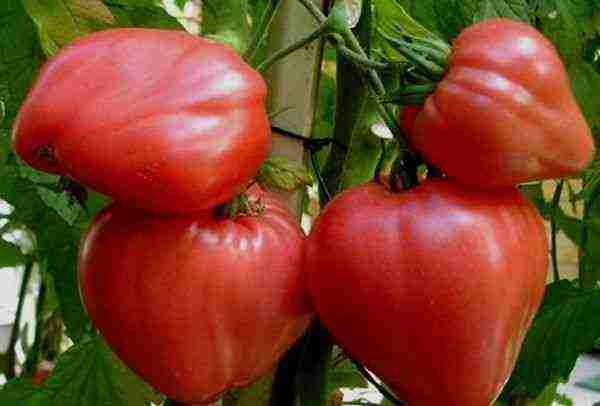 Big Mama
Big Mama
Gift for a woman
A brief description of:
- medium early ripening;
- growing season 100-115 days;
- fruits of a rounded shape of red-pink color;
- the mass of a medium-sized tomato is 200-280 gr.;
- yield - 3.7-5 kg per bush.
The hybrid was bred by Russian breeders for growing in open ground and in a greenhouse. It is best to plant in the middle lane and in the south of the country.
Advantages of the variety: sweet tomato taste, tender juicy pulp, high yield.
Among other things, the plant is resistant to diseases and pests, easily tolerates drought.
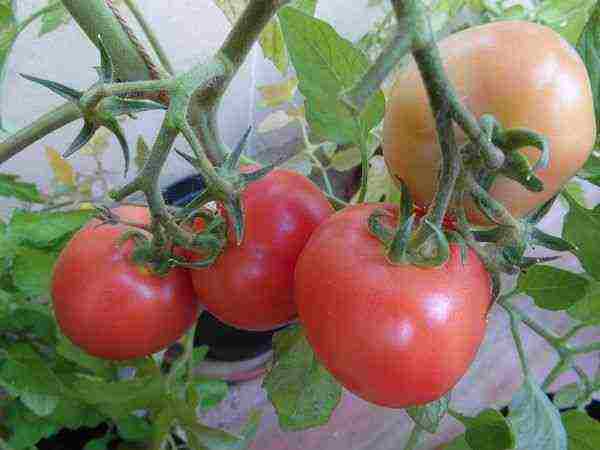 Variety Gift for a woman
Variety Gift for a woman
Of the shortcomings, the demand for regular feeding is noted.
The best fruitful sweet varieties for the Urals
King of the early
A brief description of:
- growing season 80-90 days;
- fruit weight - 250 gr. (the first tomatoes are larger, reaching 500 gr.);
- yield - 4-5 kg per bush.
The variety King of the Early was bred by domestic breeders, registered in 2005. Ideal for growing in central Russia, the Urals and northern regions, in particular in the Astrakhan region, Krasnodar Territory.
Advantages of the Early King: strong immunity, tolerance to fungal infections, good taste, universal use of the fruit. The disadvantages relate mainly to the rules of care: exactingness to watering and lighting.
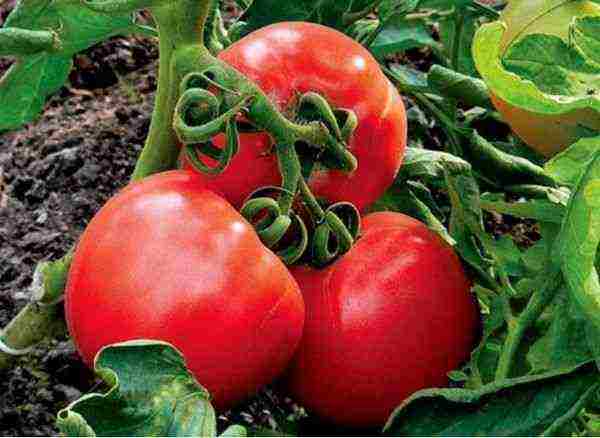 King of the early
King of the early
Grandma's secret
A brief description of:
- growing season 115-125 days;
- bush height over 1.5 m;
- fruit weight - 450-600 gr.;
- yield - up to 8 kg.
The culture is grown throughout Russia. The Babushkin secret variety was bred by Siberian breeders, registered in 2007.
Large tomatoes have excellent taste and sweet pulp. The skin of the fruit is dense, so the vegetable retains its freshness for a long time. The plant is tolerant to powdery mildew and fusarium. The only drawback is the tendency to cracking.
Pink flamingo
A brief description of:
- growing season 90-110 days;
- bush height - 1.5-2 m;
- fruit weight - 200-300 gr.;
- yield - 5-6 kg per plant.
One of the characteristics of the Pink Flamingo variety is its taste, which surpasses many other tomato varieties in sweetness. The culture grows well in the middle lane and in the south of the country. In regions with harsh climates, cultivation under cover is recommended.
The plant is tolerant to most fungi, but it is susceptible to insect attacks, so prevention should not be neglected.
Samara
A brief description of:
- vegetation period 90-96 days;
- bush height 2-2.2 m, pinching and pinching is required;
- fruit weight - 85-100 gr.;
- yield 3.7-4.3 kg per bush.
The tomato is resistant to cracking, strong immunity resists many diseases and pests, which makes it easier to cultivate a vegetable. The high yield and universal use of the fruits have raised the hybrid to the category of popular among industrialists and summer residents.
What early varieties of tomatoes to plant in the greenhouse?
Hurricane
A brief description of:
- vegetation 93-103 days;
- bush height - 1.9-2.3 m (requires shaping the stem and pinching);
- fruit weight - 35-45 gr.;
- yield - 4 kg per bush.
The advantages of the variety are: early ripening, presentation and good taste, the safety of vegetables during transportation. The fruits are not prone to cracking. The disadvantage is the weak resistance to late blight.
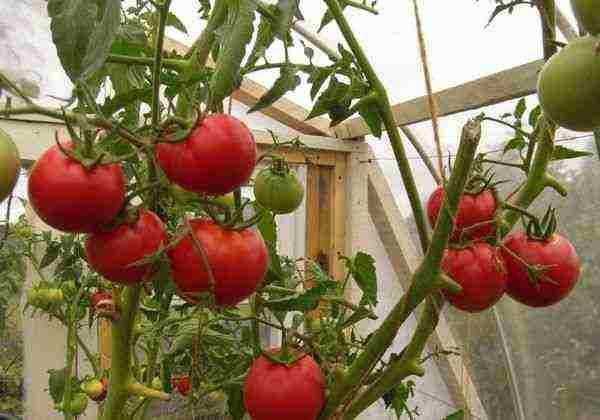 Hurricane Tomatoes
Hurricane Tomatoes
Verlioka
Brief characteristics of the Verlioka variety:
- growing season 90-105 days;
- plant height - 1.5 m;
- fruit weight - 80-100 gr.;
- yield up to 5 kg per bush.
Among the advantages of the variety: ease of care, good immunity, excellent fruit taste... However, the plant is demanding on the nutritional value of the soil, and pinching is also required.
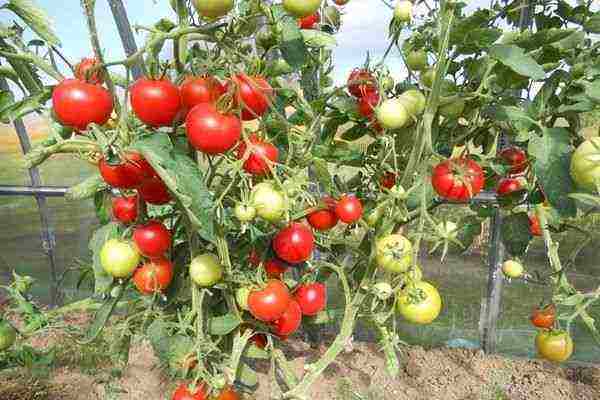 Verlioka variety
Verlioka variety
Highest Yielding Polycarbonate Greenhouse Tomatoes
Pink raisins
A brief description of:
- growing season 86-90 days;
- plant height - 1.5 m;
- fruit weight - 60-100 gr.;
- yield - up to 6 kg per bush.
The culture is resistant to diseases and pests, tomatoes have an excellent taste, their use is universal.
The peculiarity of the variety is abundant and long-term fruiting, unpretentiousness to weather conditions.
The tomato has no significant drawbacks.
Mikado pink
A brief description of:
- growing season 90-95 days;
- plant growth - 1.7-2.3 m;
- fruit weight - 300-600 gr.;
- yield - over 5 kg per bush.
Indeterminate variety Mikado, distinguished by excellent immunity, taste of tomatoes and their universal use. Cons: tendency to cracking, the need to form a bush and pinch.
Miracle of the earth
A brief description of:
- vegetation period 110-125 days;
- bush growth - 1.5 m;
- fruit weight - 200-250 gr.;
- yield - over 4.5 per plant.
The wonder of the earth variety is unique in that it was bred by an amateur breeder, therefore, it is problematic to purchase seeds. The advantages of the Miracle are: high yield with a long fruiting period, good fruit taste and long shelf life, excellent transportability. Tomato is not susceptible to cracking, shows resistance to fungal infections.
Medium and late greenhouse varieties
King of Kings
A brief description of:
- growing season 120-135 days;
- plant growth - 1.45-1.85 m;
- tomato weight - 500-1000 gr.;
- yield per bush - 5.5 kg.
The real giant has good resistance to late blight and rot. The size of the tomato is supported by its excellent taste, which justifies the name.
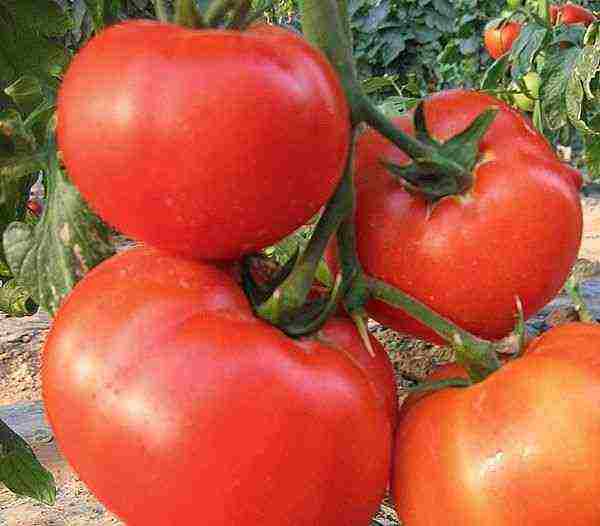 King of Kings
King of Kings
The crop has a long shelf life, but there is a tendency to cracking.
Bobcat
A brief description of:
- growing season 120-130 days;
- plant height - 50-70 cm (sometimes the bush reaches 1.2 m);
- tomato weight - 180-240 gr.;
- yield over 4 kg.
A hybrid of Dutch origin was registered in Russia in 2008. The tomato is recommended for cultivation in the middle lane. In the northern regions, it is grown under cover.
The main advantages of the Bobkat variety: it easily tolerates drought, shows resistance to most diseases of nightshade crops, gives a consistently good harvest. The disadvantage is the ripening period (late ripening), so it can not be grown throughout the entire territory of the Russian Federation.
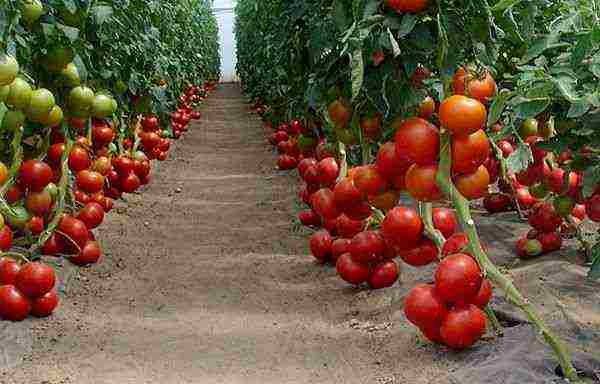 Bobcat Tomatoes
Bobcat Tomatoes
Rocket
A brief description of:
- growing season 115-125 days;
- plant height - 50-70 cm;
- tomato weight - 40-60 gr.;
- yield - 5-6.5 kg per bush.
The tall Raketa variety was bred by domestic breeders, was registered in 1999. The best harvest results were noted in the southern regions, but thanks to proper agricultural technology, a record number of fruits can be harvested in the middle lane.
The plant is resistant to rot and late blight, its short stature allows you to cultivate a vegetable in open beds, in greenhouses and even on a balcony. The culture is demanding for watering, fertilizing, as a result of violation of agricultural technology, tomatoes can crack.
French bunch
A brief description of:
- medium late ripening;
- plant height - 1-1.5 m;
- tomato weight - 80-100 gr.;
- yield - 3.5-4.7 kg per bush.
The advantages of the French Grape variety are unpretentiousness to agricultural technology, excellent taste of fruits, beautiful appearance of tomatoes. The crop is well preserved and transported thanks to the dense skin. The disadvantage can be attributed to the late ripening of fruits, the climatic features of some regions do not allow ripe tomatoes to be removed from the garden at the end of the season.
Abakansky
Brief characteristics of the Abakansky variety:
- medium late ripening (115-125 days);
- plant height - 1.5 m;
- tomato weight - 250-300 gr.;
- yield per bush - 5 kg.
Pink tomato can reach 800 gr with proper agricultural technology.
The appearance and taste of the vegetable are excellent. The culture reacts positively to mineral supplements, shows resistance to fungi. Disadvantages are: a weak tomato stem that cannot withstand large fruits (a garter is required), the requirement for watering and lighting.
A large assortment of varieties makes it possible to choose options for tomatoes for summer salads and winter preparations.
Real battles unfolded during the voting for the most productive varieties of tomatoes that our readers have grown in their beds. Evaluated according to different criteria - from frost resistance and keeping quality, to taste and pickling qualities.
Amateur tomato growers from our social network group voted for many varieties, which pleased us with their unpretentiousness and productivity in specific conditions. It is simply impossible to mention all varieties of tomatoes in one article. Therefore, we will list only those who, according to practitioners, have become the absolute leaders of the rating. And who, if not tomato growers, can be trusted 100%.
Let's start at the bottom of the rankings and tell you about the tomato varieties that received the least number of votes. However, this does not mean that these tomatoes are bad or weak and should not be grown. It's just that it's not customary to argue about tastes.
Eagle heart
A tomato with the proud name Eagle Heart occupies the bottom line of our top. Everyone who grows these giant tomatoes with an elongated tip, shaped like a heart, leaves only positive reviews about it. Fruit weight reaches 600-800 g, and sometimes up to 1 kg. One such pink-raspberry fleshy "lump" - and you can feed the whole family with a salad! The tomato pulp is sugary, juicy and sweet.
The variety is determinant, with an average ripening period - in a greenhouse with nutritious soil, the bushes grow up to 170 cm and need to be pinned and tied. Outdoors, they may be slightly lower. But their yield sometimes exceeds 10 kg per bush. For the sake of such impressive results, no effort is spared. Moreover, the tomato shows resistance to most diseases, does not lose its shape during transportation and can be stored for up to 3 months.
Koenigsberg
A mid-season variety of indeterminate (up to 2 m high) tomatoes, which confidently took the 10th line of our amateur rating. The first fruits usually ripen in 110-115 days from the moment of sowing the seeds. Even beginners will be able to cope with their cultivation. The variety has been tested and hardened in the harsh conditions of Siberia. Therefore, you can safely plant these tomatoes in open ground. Their yield indicators are impressive - from 4 to 18 kg per 1 sq. M.
"Königsberg performed well both in the greenhouse and in the OG." Yuri Kuzminykh.
Oblong fruits ripen in clusters of 6 pieces, they weigh an average of 300 g, under favorable conditions the weight can be 2-3 times higher than the standard declared by the manufacturer. Both the skin and the flesh of tomatoes are dense, which makes them easier to transport. They are, of course, healthier fresh, but in the form of juice, thick paste or sauce, they are also very tasty. There are varieties of red and yellow color (Golden Koenigsberg).
“Königsberg is an excellent variety, bearing fruit throughout October, from one bush to 2 buckets. In the greenhouse, of course. "Lyudmila Petlyuk.
Abakan pink
On line 9 - a variety of medium late ripening (110-120 days from germination), determinant type (height - 70-80 cm). In a greenhouse, it can grow up to 140-150 cm. The bush must be formed into 1-2 stems and tied up. Fruits of pink color, heart-shaped (weighing up to 300 g) with tasty dense pulp will ripen on it. If cared for correctly, tomatoes weighing up to 800 g can be removed, which rival the popular Bull Heart in size.
There are many positive reviews about the cultivation of this tomato, no one criticizes it. It can be grown in Siberia, and a light film cover will be enough for the bushes to protect them from recurrent spring or late autumn frosts. This representative of the nightshade is rarely sick; Colorado beetles will have to be driven away only from immature seedlings. In a word, he will not create much trouble for you, but he will delight you with tomatoes - both in a salad in summer and in preparations for the winter.
“I recommend Abakan pink. Unpretentious and very tasty. " Lydia Domnikova-Kazakova.
Chio-chio-san
Of the shortcomings of this indeterminate (sometimes it grows up to 2 m) tomato - only the need for a bush in support and formation. The rest is a set of advantages! It is resistant to adverse conditions and can grow even in Siberia and the Far East. It bears fruit well not only in the greenhouse, but also in the open field. It is not afraid of the main diseases of the nightshade.
“In the greenhouse, I am always pleased with the Chio-Chio-san variety from Gavrish. Maria Dolzhikova.
According to the ripening period, the tomato belongs to the mid-early - from the appearance of the first shoots to the beginning of fruiting, 100-120 days pass. It will not fail with the harvest either - although the tomatoes are small (on average about 30-40 g), but they ripen up to 50 pieces. on the brush! So the harvest from a bush with proper care is 4 kg and can reach a record 6 kg. And the taste of this tomato is excellent! And in the blanks, it looks very presentable.
“Chio-chio-san - sweet, very productive, tall, with up to 50 even thin-skinned sweet tomatoes in a bunch! Universal for both food and preservation. " Tatiana Vznuzdaeva. Tula region
Apple tree of Russia
Tomatoes with such a quivering name could not help but get into the top - they ripen early - from the time the first shoots appear until the bushes are completely covered with small round fruits (weighing about 100 g) that really look like bulk apples, it takes from 118 to 135 days.
Many consider this tomato problem-free - it is determinant, standard bushes grow low - up to 100 cm; you do not need to give them a shape and pinch them; they are not capricious and feel great and set fruits both in the greenhouse and in the open field. On one bush, up to 100 neat tomatoes suitable for canning can ripen at the same time - the skin will not burst, there is no need to be afraid. Not a tomato, but just a feast for the eyes!
Monomakh's hat
6th step of the conditional "pedestal". These bright red tomatoes will appeal to lovers of large fruits - they weigh from 400 to 900 g. The pulp has a balanced taste due to the harmonious ratio of acids and sugar.
The type of fruiting is medium early (90-110 days pass from the moment the seedlings are planted). Bushes are indeterminate, formed on a trunk. The plant successfully resists diseases, but prefers warmth to the cold, so in the northern regions it is better to plant it in a greenhouse. In conditions of protected ground, the yield is impressive and reaches 20 kg per 1 sq. M. In the garden, the indicators are also decent - up to 8 kg per bush.
Puzata khata
In terms of the number of votes won, he did not go far from the Cap of Monomakh. The appearance of these tomatoes fully explains the name. Large (300 g), pear-shaped, ribbed, just like squat houses for gnomes, these tomatoes ripen early - 105-110 days after transplanting. True, they turn red gradually if there is a lot of heat and sun.They are grown in the open field and under a film, where they ripen faster. The fruits are fleshy, very sweet and juicy to the taste.
The bushes are indeterminate, but even in a greenhouse their height rarely exceeds 170 cm.However, it will not be possible to do without formation. The stems are thin and need a garter, as they can lie under the weight of the fruit. And the yield of these tomatoes, ripening in brushes of 3-5 pcs., Show quite decent - 10-11 kg per bush. They are not very susceptible to common cultural diseases, but preventive measures of protection have not prevented anyone yet.
“This year, too, I want a Puzata hut. Last year they were with a friend - just a miracle! ". Marina Samoilova.
Golden domes
The votes gained allowed these tomatoes to occupy the 4th line of the rating. In their "piggy bank" there are many good reviews, since the variety has almost no flaws, for which it is recognized and loved by many. It is highly resistant to major diseases, and timely applied insecticides will ward off harmful insects.
Determinate bushes (height from 90 to 150 cm), medium ripening period (100-116 days). You will still have to form it into 2-3 stems and tie it up, so it will not work at all without effort on your part. The yield is very good - up to 13 kg per bush with an average weight of tomatoes of 200-400 g, and if the care is good, they will gain all 800 g! Ripe fruits are bright orange, juicy even in appearance. The pulp is fleshy, very tasty, sweet.
“I love golden domes very much - they are tasty, fruitful and beautiful. Excellent variety! " Love Chernoguz.
Eagle beak
The bronze "medal" and the 3rd place in the rating is received by the Eagle's beak, which is popular with many tomato growers! The variety is mid-season (110-115 days), semi-determinant - the height of strong bushes reaches 120-150 cm. Competent formation, tying to a trellis and timely pinching will help them develop harmoniously and bear fruit well. Under ideal conditions and with proper agricultural technology, the yield can be up to 8 kg per bush.
"The eagle's beak is the best, I have no competition yet, the leader for today." Olga Nesmeyanova.
The fruits are large, of an unusual shape, with an elongated and curved tip, similar to a beak. On average, they weigh 200-400 g, but some grow up to 800 g. The pulp is dense and juicy, with a sweetish taste.
The variety is resistant to the main diseases of the nightshade - late blight, fusarium and tobacco mosaic virus. Tomatoes tolerate transportation well due to their dense skin; they do not crack when canned.
"I really like the Eagle's Beak !!!" Nina Belevtseva.
De Barao
Breaking away from the rivals, the honorable 2nd place in the top varieties is occupied by the famous De Barao tomato variety. The variety is late ripening (ripening periods vary from 110 to 130 days from the moment of planting seedlings), indeterminate (2-3 m), sometimes bushes can grow up to 4 m. The main advantages of the variety are its cold resistance, shade tolerance and yield. These tomatoes grow well and ripen successfully in all regions with a temperate climate, both in greenhouses and in the open field. Plants are so unpretentious that even inexperienced gardeners can take care of them.
"Tall De Barao gives stable yields in any weather: rain or heat, even in the shade." Tatiana Trach.
The yield of De Barao is exceptional - from one bush you can collect from 4 to 10 kg of strong, oblong fruits weighing about 100 g. It is noteworthy that the plants give the crop for a long time (up to 3 months). There are varieties with pink, red, yellow and black fruits. Tomatoes keep well due to their dense skins and are also suitable for pickling or pickling for the same reason.
“The only one who stood in the greenhouse and matured in October is De Barao. Persistent tin ... ". Tatiana Gorodetskaya.
Bull heart
The generally recognized and most popular variety of Bull's Heart becomes the absolute leader of the national tomato rating, which has received a record number of votes! A real Senior Tomato in all respects!
The variety is late-ripening - the first fruits (5 pieces in a brush) ripen 120-130 days after germination. In the open field, the yield is from 3 to 5 kg of tomatoes per bush. In a greenhouse, this figure can increase to 12 kg. Determinant type bush - stems grow up to 1.5 m or more.To achieve record yields, do not neglect leaving - timely formation and garter to the support, preventive treatment for late blight - and the harvest will not keep you waiting!
Tomatoes are heart-shaped, bright red in shape. Hybrids range in color from lemon and raspberry to deep brown and black. Average weight - from 300-500 g to 800 g and even up to 1 kg. On the bush, large specimens are located closer to the ground, smaller ones - in the upper part of the stem. The giant size of the fruit, dense pulp and unique sweet taste make this tomato an unconditional favorite of all gardeners without exception. This is confirmed by the voting on the portal and our rating based on its results.
“I planted a Bull's heart, even in a cool and rainy summer season - it gave a good harvest. The husband adores him! " Tatiana Arzhanova.
If you still do not grow tomatoes because of fears that the weather will let you down, you will not be able to cope or the plants will die due to diseases or improper care, we hope that positive feedback and recommendations from the members of our Tomato Growers Club will convince you otherwise. And over time, on the pages of our website and in the group in social networks, you will also begin to enthusiastically discuss your new achievements and share your successes!
See the entire rating and comments of the participants
Modern varieties of tomatoes for the greenhouse must meet high requirements for a whole range of features. In this article, we will consider the best tomato varieties for 2017-2018, suitable for growing in greenhouses and greenhouses in various regions.
Indoor ground creates conditions close to the climate of this vegetable's homeland (tropical America), which allows you to get the most out of a small area. Heat accumulation and protection from cold, reliability are the most important advantages of a greenhouse over open ground.
But there are also disadvantages: excessive heat and high humidity, stagnant air and poor pollination, massive attacks of infections and pests, lack of taste occur. The genetically inherent potential of the variety plays an important role in the final quantity and quality of the crop.
Selection factors
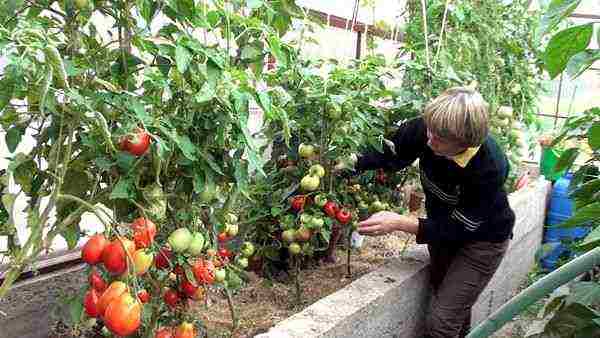
It is not easy to single out the best varieties of tomatoes for greenhouses among the variety of assortments in 2018. Any gardener has his own understanding of the "best", each land plot has a special microclimate. Should be considered:
Purpose of growing: for the needs of the family or for sale
For implementation on the market, options are selected with standard, leveled fruits, transportable, with the highest possible efficiency. For personal needs, everything is determined by your own predilections.
Purpose and variety of fruits
We love tomatoes for their incredible variety: in terms of ripening, shape, color, taste, nutritional value, culinary possibilities.
Before the start of the sowing season, you need to decide on your expectations: how many early vegetables you want, and how much will go for storage, whether whole-fruit canning is planned, etc. etc. Bias in favor of one group can lead to disappointment later on.
The need for stability or exoticism
There are gardeners with an ineradicable thirst for experimentation, for whom the indicators of productivity and reliability are not the most important.
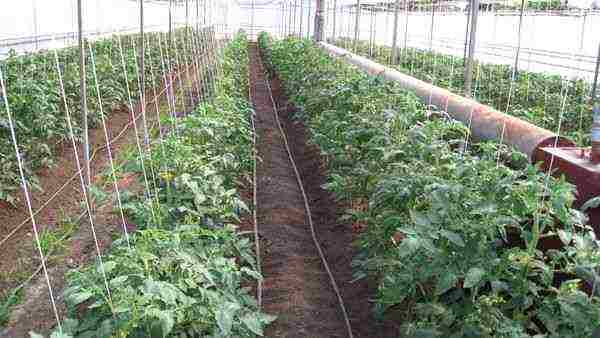
Greenhouse design features
Many parameters matter.
- The assortment of tomatoes for year-round and summer greenhouses will differ. Plants for winter greenhouses (equipped with special heating) are expected to be more stress-resistant and tolerant of lack of sunlight.
- The temperature regime of the greenhouse plays a huge role.The possibility of timely through ventilation, length, air volume, number and location of doors and vents, thermoregulation automation, greenhouse materials (film, polycarbonate, glass, agrofibre) - all this affects the choice of tomato variety.
In an optimal, stable microclimate, any options will be successful.
But breeders also offer specially bred forms that can withstand extreme heat, temperature contrasts, and cold snaps.
Water supply
Tomato plants like constant moderate humidity in the root zone. If it is not possible to ensure this, it is necessary to plant varieties that are not prone to cracking of fruits, and are resistant to drought.
Disease prognosis
This factor is one of the most important in tomato greenhouse cultivation. Indoor ground accumulates many harmful pathogens, which are very difficult to resist.
Special hybrid varieties deal with this problem more successfully.
But some vegetable growers are principal opponents of hybrids because of their fear of GMOs, and some do not like the “rubber” density and fresh taste of the fruit, and the cost of hybrid seeds is high, there is a risk of running into a fake.
Giving preference to non-hybrid forms, you need to carefully consider agricultural technology: possibilities of crop rotation, disinfection of seeds and greenhouses, establishment of ventilation, regular chemical or biological treatments, etc.
Bush height and potential yield
Far from everything is decided by agricultural technology, each variety has its own "ceiling". Of course, the most productive varieties of tomatoes for greenhouses are the earliest ripening, but with a long return. As a rule, these are tall tomatoes - indeterminate. They are necessarily stepson, taking them out in 1-2 (less often 3) trunks.
Can determinate tomatoes be planted in a greenhouse? In general, the answer is yes, but the specific choice depends on the situation:
- Tomatoes with a determinate type of growth are convenient, but not too low - the so-called "semi-determinant". They themselves are inhibited in development at a height of 120-150 cm, tying several tiers of brushes. For the further continuation of their growth (if necessary), the upper stepson is left - he will replace the stopped top.
- Undersized determinants are sometimes used as curb compactors for greenhouse beds.
- Early maturing determinant tomatoes are a forced choice for greenhouses heavily infected with fungal and bacterial infections (when a significant part of the crop is lost annually). An early and friendly harvest will have time to ripen before the mass development of infections. After harvesting the fruits, the greenhouse is occupied with other vegetables (greens, radishes) or siderates.
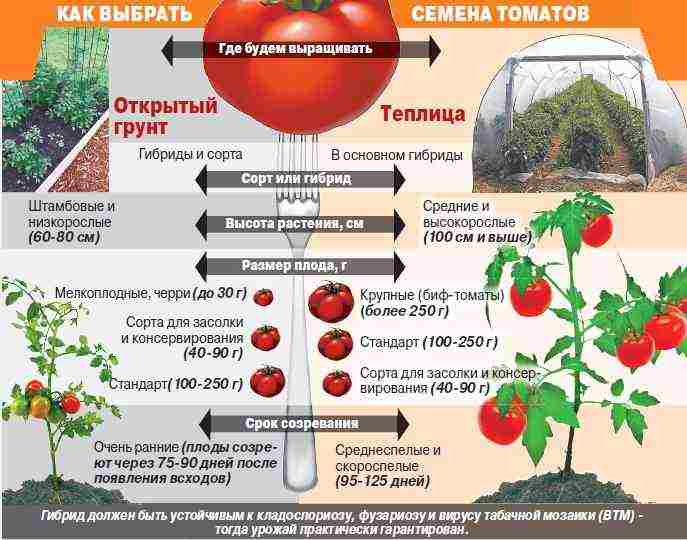 Scheme: How to choose tomato seeds for greenhouses and open ground
Scheme: How to choose tomato seeds for greenhouses and open ground
Is it possible to grow different varieties of tomatoes in the same greenhouse?
The answer is simple: it is possible and even necessary. Tomatoes are a self-pollinated crop, and the harvest will set even if there is only one variety, this is quite acceptable. But this will not satisfy all needs; in addition, diversity reduces the role of the factor of instability and the risk of failure. It is advisable to plant both proven varieties and new selection annually.
New varieties of tomatoes
New items are the most resistant to diseases. Breeding is also carried out to increase yields, evenness of fruits, and improve taste.
- Alexander the Great F1
- Accordion
- High society F1
- F1 wrist stroke
- Baba
- Clear Falcon F1
Review of the best varieties of tomatoes 2017-2018
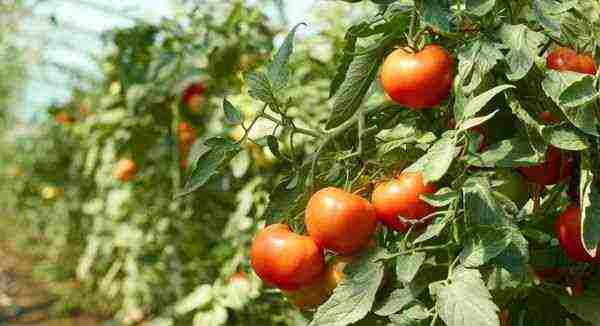
For the convenience of choosing, tomatoes can be grouped by purpose and various characteristics.
For polycarbonate greenhouses
Choosing varieties of tomatoes for a polycarbonate greenhouse must be especially careful. They are expected to get the most out of them.
The most productive are modern hybrids with complex disease resistance, vigorous growth, heat tolerance, and stable ovary. In healthy greenhouses with good ventilation, fleshy non-hybrid varieties are also successful.
DJ F1
An early Dutch hybrid with the highest resistance to a complex of diseases and nematodes. It blooms successfully and grows even under extreme heat and other stresses. Long-term fruiting. Fruits of classical shape and color, transportable, up to 160 g.
Kirzhach F1
Popular disease-resistant tomato from the Russian company "Gavrish". Combines mid-early ripening with excellent fruit size (range from 160 to 500 g). They are transportable, do not burst. More than 6 kg can be obtained from one bush.
Drive F1
An early ripening hybrid from "Semko" with amicable response and high overall yield (more than 20 kg per square meter). Tolerant to nematodes and many diseases. The internodes are close together. The tomatoes are round, leveled - 150 g each. The ovary is stable even at high temperatures.
Russian Tsar F1
A mid-early tomato from the Sedek company with pink spherical fruits, size 240 g. The brushes are densely arranged, each bearing 5-6 ovaries. A powerful bush that resists infections well.
Super Red F1
Heat-resistant and disease-resistant hybrid of Dutch production. The stem is semi-determinate, strong, not spreading. The average weight of dense tomatoes is 230 g.
For foil greenhouses and greenhouses
In greenhouses and greenhouses covered with plastic wrap, indeterminate and semi-determinant varieties and hybrids are planted.
It is desirable that they successfully cope with sudden changes in temperature and infectious attacks.
Scarlet Caravel F1
A mid-season hybrid with even (130 g) fruits, there are more than a dozen of them in the brush. Appointment - pickling.
Intuition F1
Popular cluster tomatoes from the Russian company "Gavrish" are perfect for film greenhouses. Many gardeners like to harvest with whole brushes. Fruits do not burst, weigh 100 g. Dates of harvest - from mid-early to mid-season. The hybrid is resistant to disease.
Bloody Mary
A new early-ripening variety from the Gavrish company with a long-term yield (up to 10 kg per bush). Plants are tall. Plum tomatoes, weighing about 350 g.
Pink Magic F1
An imported hybrid from Sakata with a unique ability to adapt to any region and weather conditions. Plants don't get sick. Lettuce-type tomatoes, while transportable. Weight up to 250 g, color - pink.
Tolstoy F1
A tall Dutch hybrid with multiple clusters (7 ovaries, more). The size of tomatoes is from 80 to 150 g. Plants do not get sick with cladosporium, verticillium and fusarium wilting. According to many gardeners, the variety is good in salting, but harsh in salads.
Large-fruited
Large-fruited hybrids are poured up to 400-500 g, non-hybrid giant varieties are capable of producing record kilogram vegetables.
Giant Novikov
Many vegetable growers consider this variety to be the standard of lettuce tomato: size from 400 g to a kilogram. The pulp is juicy, sugary, deep red. The bush is tall, with good care it can bring a dozen kilograms of fruit.
King of giants
A Siberian variety that is loved by gardeners in many parts of the country. Plants are medium-sized, mid-season. Tomatoes are sweet, weighing from 300 g to a kilogram, quite easy for a salad type. Harvest from one bush - up to 8 kg.
Malvaria F1
New mid-early hybrid from Semko (improved Malvasia). Resistant to a large number of infections. It has an excellent weight for a hybrid - 300 g and more. The yield is very high - over 35 kg per square meter.
Tungus
The variety of the St. Petersburg agricultural firm "Biotekhnika" with fruits of 400-1000 g. Gardeners really like the sugar content of the pulp; the only drawback is that the first ovaries are not too even, ribbed.
Miracle of the earth
Siberian giant variety, capable of reaching a weight of 1200 g. Average size - 390 g. According to gardeners, tomatoes are very sweet and fleshy, ripe raspberry color, ribbed. Bushes are tall. Plants are unpretentious, but they need pinching and protection from diseases.
Sweet
The sugar content increases in the sunny season with low precipitation, as well as under the influence of fertilizing with mineral elements, as a result of treatments with biostimulants (humates, Epin Extra, NV-101, Novosil, etc.). In the taste of sweet tomatoes, there is a genetically inherent predominance of sugars over acidic components.
The sweetest varieties of tomatoes - an overview on our portal.
Unfortunately, such varieties are rarely early maturing, dormant, and disease-resistant. Vegetable growers point out that simple varieties are the tastiest, softer and more sugary than hybrids. The efforts of breeders are aimed at improving the taste for hybrid forms that are more resistant to disease.
Bombay F1
A hybrid-professional from the Biotekhnika company with an excellent taste of pink fruits weighing about 300 g. It is not affected by Alternaria, root and apical rot. Ripening dates are early and mid-early.
Crimson dawn
A tall variety from the Vkusnoteka series from the Poisk company. Ripening periods are average. Raspberry tomatoes, heart-shaped, up to 400 g.
Real jam
Firm mid-early grade from the Aelita agofirm. The bush is vigorous, but compact. Fruits are oblong-pointed, orange, with few seeds.
Pudovik
A fleshy and sugary Siberian variety with a high stable yield. It ripens in average terms. Large "hearts" weigh an average of 300 g, record - up to a kilogram. Stem height is moderate.
Three sisters F1
New author's hybrid from the Gavrish firm with a sugary, delicate texture and thin skin. Weight 200 g. Bushes grow up to one and a half meters. The chanting is medium early, friendly.
Cherry
Cherry tomatoes grow well in indoor conditions, are resistant to diseases. They begin to ripen early and are suitable for picking up with whole brushes. Tall cherry varieties and hybrids bear fruit until the end of the season.
Cherry
This is a whole series of multi-colored varieties from the Gavrish company. In the cluster there are 2-3 dozen rounded fruits measuring 20 g. Their color can be red, pink, black, yellow.
Mirabella
An exotic variety with creamy butter-colored fruits, weighing 25 g each. Plants are vigorous, disease-resistant.
Blue bunch F1
An original proposal from the Russian company "NK-Russian Garden": tomatoes of exotic ink color, size 25 g. Bushes are high, ripening times are medium early.
Sweet bunch
An early indeterminate variety. Each brush bears up to fifty ovaries. The average size of one "cherry" is about 15 g. The pulp is firm and sweet.
Cherry Maxik F1
An early ripening high hybrid from the Semko firm. The brushes are densely arranged, the yield is about 19 kg per square meter. Tomatoes are deep red, round, weighing 25 g. The highest resistance to a complex of infections.
Not requiring pinning
Lateral shoots on the bushes take away nutrition from the fruits, therefore regular pinching is an important agricultural technique, especially for tall tomatoes. The efforts of modern breeders are aimed at breeding forms with weakened branching.
The first achievements in this area have already appeared, including from Russian scientists. They have earned rave reviews from gardeners.
Galaxy F1
Medium-sized bushes do not require shaping and are highly resistant to disease. The timing of the first training camp is mid-early. The brushes are densely arranged, they bear 6-7 raspberry tomatoes weighing up to 140 g.
Gunin F1
This hybrid is genetically inherent in the ability to reduce branching. Stems not too long, determinate type of growth. Maturing dates are medium early. Globular tomatoes, weighing 90-130 g. High resistance to a complex of diseases and nematodes.
Red arrow F1
This is a unique achievement of domestic selection, a laureate of many exhibitions. Weak branching. Semi-determinant plants successfully cope with stress, shading and infectious attacks.Many brushes are being formed at an accelerated rate; in each - up to a dozen ovaries, filling up to 130 g.
Favorite 6 F1
This indeterminate variety is characterized by a small number of stepchildren. It is medium early, shade-tolerant and disease-resistant. Tomatoes are very large for a hybrid - weighing 250-400 g, ripen in one brush at the same time.
Tomato varieties for greenhouses for different characteristics
The most productive
High-yielding greenhouse varieties - indeterminate, resistant to diseases and other stresses, with a long yield.
- Grandma's secret
- Victoria F1
- Marissa F1
- Strega F1
- Hilandr F1
Dutch varieties
The Netherlands is a recognized world leader in vegetable breeding. Leading seed corporations are betting on hybrids.
- Bella F1
- Big Beef F1
- Martha F1
- President II F1
- Skif F1
Siberian selection
Siberian tomatoes are stress-resistant. Perfectly adaptable to other regions.
- Grandma's kiss
- a great warrior
- Koenigsberg
- Cascade
- Siberian lights
For Siberia and the Urals
- Pride of Siberia
- The pride of the Urals
- Pearl of Siberia
- Siberian Star F1
- Siberian F1
- Ural F1
For the middle lane
- Kings of the F1 market
- Kostroma F1
- Milady F1
- Portland F1
- Pink king
For Moscow region
Below you will find a list of the best tomato varieties for greenhouses in the Moscow region.
- Bella F1
- Blagovest F1
- Kapia pink
- Podmoskovny F1
- Russian hero
Varieties of pink tomatoes
Light raspberry and pink tomatoes are traditionally considered the most delicious.
- Brandy pink
- Vermilion F1
- Dessert pink
- Fig pink
- Pink Beef F1
- Pink Rise F1
- Pink spam F1
For salting
Salted and pickled products should have a strong skin and dense pulp, not crack during heat treatment. Record weight is not needed, optimally 50-120 grams. The shape can be spherical, elongated, pear-shaped.
- Verlioka plus F1
- gold fish
- Palenque F1
- Peter the Great F1
- French bunch
- Japanese truffle
Disease resistant
For greenhouse vegetables, the ability to resist pathogens - viruses, bacteria, microfungi is especially important. The most aggressive infection - late blight - has not yet been completely defeated, but there are varieties that are relatively resistant to late blight (mostly hybrid).
- Aksinya F1
- Eupator F1
- Zhenaros F1
- Pablo F1
- Typhoon F1
Early (early ripening) varieties
Early ripe greenhouse tomatoes, in contrast to ground tomatoes, are distinguished by a prolonged fruiting period. The first fruits reach ripeness very quickly (about three months after the beginning of the growing season).
- Bigorange F1
- Overture F1
- Checkbox
- Jaguar F1
Undersized
Low-growing varieties of tomatoes for greenhouses reach a height of about half a meter or slightly higher. Garter required.
- Hippopotamus crimson F1
- Butuz
- Half-fast F1
- Blush ball F1
- Severyanka
Tomatoes for the greenhouse: the best varieties according to the reviews of gardeners in 2018
At the beginning of the sowing season, some gardeners think - what kind of tomato to choose for growing in a greenhouse this time? The reason for thinking may be different - some were not satisfied with the yield or taste of the fruits grown last year, others want to try something new.
To make it easier to choose, let's try to determine which varieties of tomatoes according to user reviews in the past 2018 are the most:
- delicious;
- sweet.
The most delicious varieties of tomatoes
Taste preferences, as you know, are different for different people. This also applies to the evaluation of the taste properties of tomatoes. However, the juiciness of the fruit (not to be confused with "wateriness"), its aroma, the presence or absence of a harmonious combination of the main flavoring components in it, is perceived by the overwhelming majority of people approximately the same and is a fairly objective basis for classifying the fruit as tasty or not.
According to the reviews of most consumers, many domestic tomato varieties are superior to foreign ones in this parameter, including varieties of such famous breeding companies as Bejo Zaden or SYNGENTA AG, although they are inferior in a number of other characteristics (yield, transportability, disease resistance, etc.).
If you try to summarize the reviews, then often referred to as "tasty" varieties such as:
- Dad pink;
- Monomakh's hat;
- Giant pink;
- Budenovka;
- Pound pink rosemary.
These are large-fruited varieties that are excellent for fresh consumption, as well as for making salads and juice.
Note that pink tomato varieties are on average less productive than red ones, but according to most people, they have better taste. This list is certainly not limited to "tasty" varieties and other consumers may have their favorite types of tomatoes.
Sweet varieties of tomatoes
The concept of a sweet tomato variety is more specialized than a “tasty” variety. And here, too, most of the reviews were on the side of domestic varieties over foreign ones.
The explanation is simple. Foreign varieties are focused on commercial success - high yield, transportability, keeping quality, preservation of the presentation for a long time.
In contrast, tomatoes grown in greenhouses for personal consumption have higher taste requirements than those listed above.
Consumers speak well of such sweet varieties as:
- Malachite Box;
- Pink honey;
- Truffle;
- Dimensionless;
- Bull heart;
- Honey King;
- Chernomor;
- Orange giant.
There are also good reviews for other sweet varieties in all varieties of tomatoes by the appearance of their skin - green, orange, pink, red and purple.
Cultivation of tomatoes in polycarbonate greenhouses is significantly different from growing the same vegetables in open conditions. The peculiarities lie in the rules for caring for plants at each stage of development, the timing of fruit ripening, as well as the risk of diseases. Many common problems can be avoided by choosing the best polycarbonate greenhouse tomato varieties based on the growing area. Special greenhouse varieties of tomatoes perfectly tolerate indoor conditions.
Features of greenhouse tomatoes
Moscow region, Siberia, Central Russia - each of the regions has its own characteristics of vegetable cultivation. If for the Moscow region early and mid-season species are a recommendation, then for colder regions this advice is transformed into a necessity. Explore the recommended tomato varieties for different climatic conditions, see how their fruits look in the photo to find the best seeds for your site.
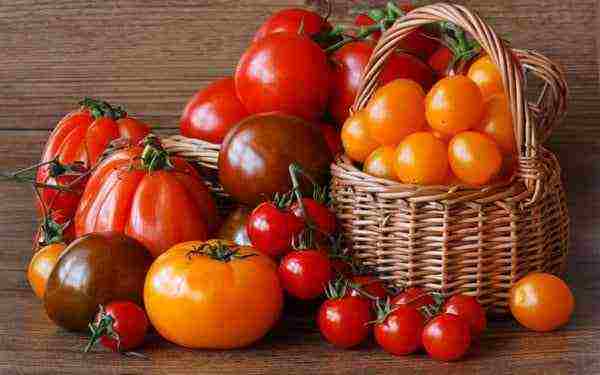
Variety of species
Selection of varieties for different climatic zones
Zoning should become a fundamental selection criterion. Polycarbonate greenhouse tomato varieties for different regions have their own external characteristics. Zoned seeds only in a specific climatic zone are able to provide the best indicators of ripening and productivity, transportability, keeping quality, taste.
The southern representatives of the nightshade are distinguished by powerful foliage, which is necessary to shelter the fruits from the scorching rays. In addition, they develop more slowly, gaining power towards the end of the season. A calmer course of life processes gives "southerners" maximum resistance to external negative conditions.
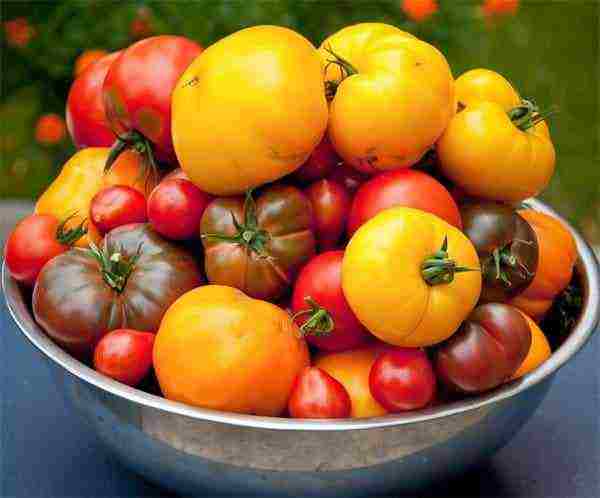
Greenhouse-grown tomatoes
Northern species are cultivated in short summer conditions. An accelerated development program is visible at every stage:
- fast growth,
- fast formation of the crop,
- rapid maturation.
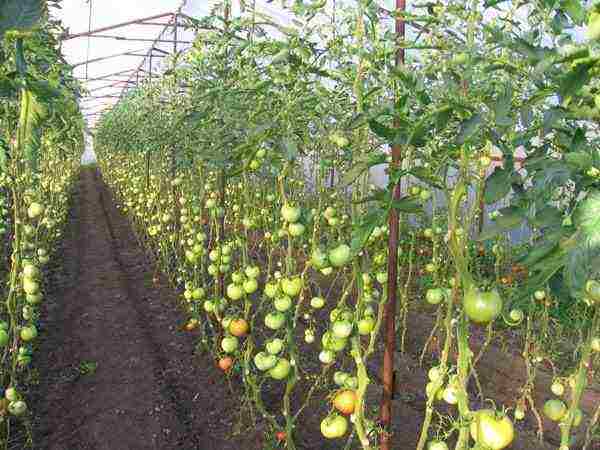
Southern tomatoes
Even transplanting these varieties into warmer conditions does not contribute to the abundance of fruiting and longevity. Rapid aging leads to the fact that the ripening crop does not receive enough nutrition. The leaves of northern tomatoes are narrower in order to open the fruits to the sun as much as possible.
The varieties developed for the Moscow region take into account the characteristics of the region. Most of the offered seeds are of the indeterminate type. Temperature fluctuations, humidity indicators, problems with natural light - all this can negatively affect varietal traits, even hybrids.
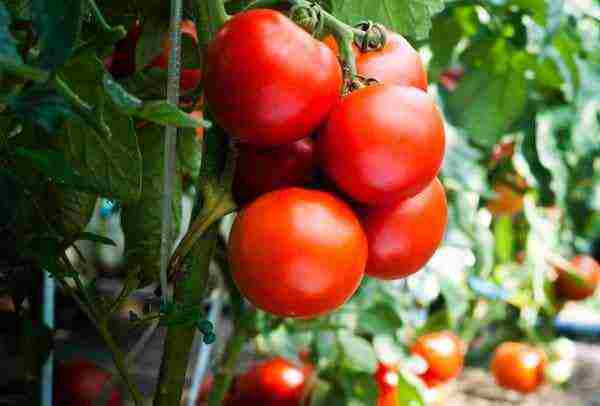
Greenhouse northern tomatoes
Recommended varieties:
- In greenhouses near Moscow grow best: "de barao", "nevsky", "sweet bunch", "andromeda F1".
- In the middle lane, de barao also has good performance. Seeds "jane", "honey drop" are in demand.
- The best varietal indices in hybrids are "Ivanhoe F1", "Alexia F1", "Pink Lady F1", "Demirosa F1".
- In conditions of risky cultivation of vegetables, both hybrids and original varieties grow well.
- “Siberian early ripening”, “Berdskiy”, “Alsou”, “King of Siberia”, “Titanic F1”, “Bersola F1”, “Beautiful Lady F1” manage to fully mature.
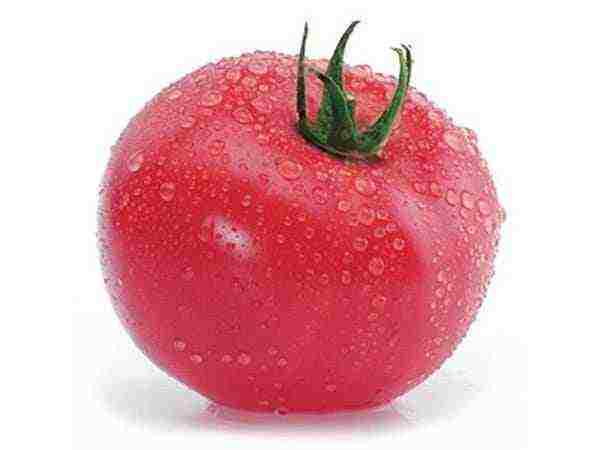
Kasamori F1
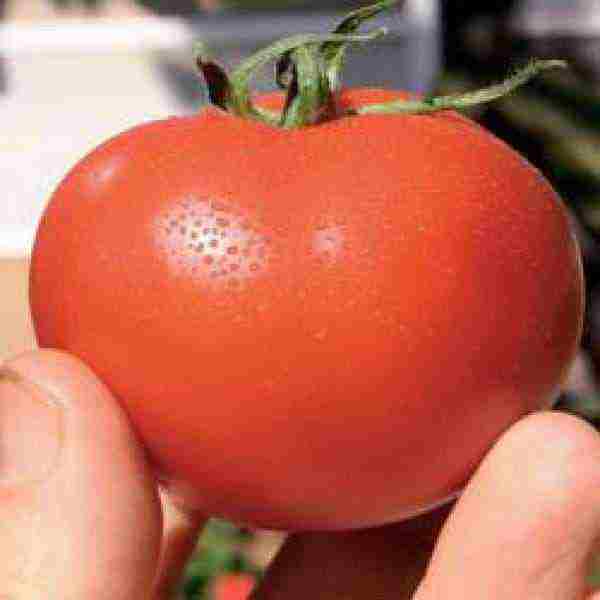
Ivanhoe F1
Low-growing tomatoes for greenhouses
"Sovereign F1" and "Caspar F1" are popular undersized varieties of polycarbonate greenhouse tomatoes, growing up to 80-100 cm. "Sovereign F1" brings the first good ripe crop after 95-100 days. The external feature of a tomato is the presence of a spout at the top. By the end of the season, the fruits become smaller, at the peak of fruiting, the average weight of a tomato is about 170 grams. When growing this hybrid in polycarbonate greenhouses, it is important to:
- Provide the plant with the maximum amount of light (there should be no shading trees or buildings nearby).
- Protect the bush from drafts.
- Provide sufficient temperature for growth.
- Monitor the overall humidity in the greenhouse: an increase in the indicator will negatively affect pollination.
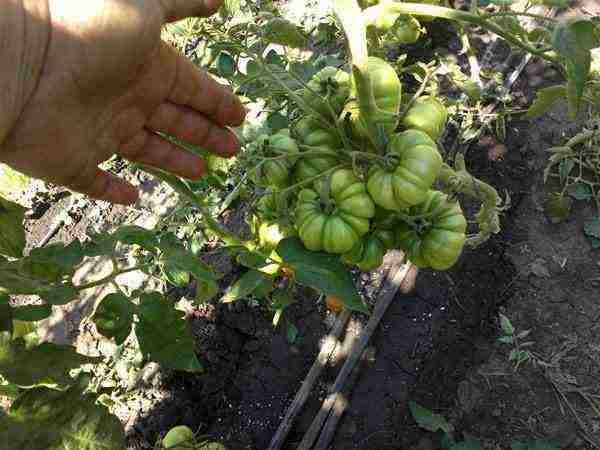
Low growing tomatoes
"Caspar F1" is ideal for polycarbonate greenhouses located in the Moscow region. The fruits grow up to 130 grams in three months after germination. The best examples are 200 grams. The tomato has an average taste. Some farmers point out the dense skin of the fruit as a negative quality. This feature makes Caspar F1 more suitable for transportation and long-term storage.
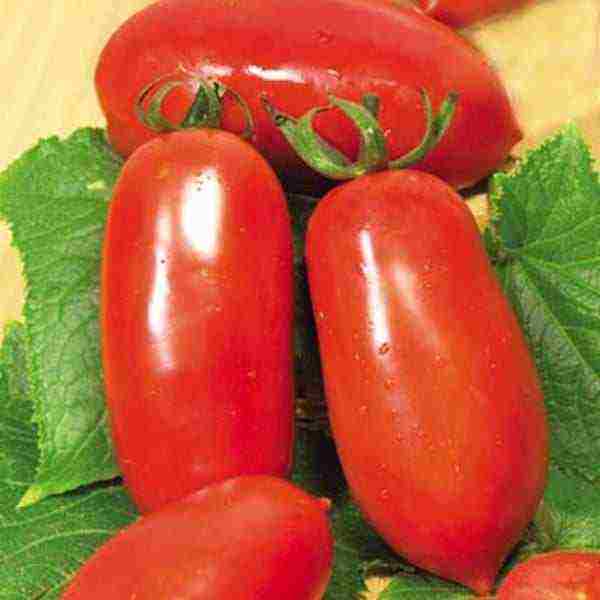
Caspar F1
The sweetest tomato varieties
It is preferable to look for sweet varieties of tomatoes for a greenhouse made of polycarbonate among yellow or raspberry ones. The unusual color is a vivid evidence of aroma and pleasant taste. Sweet tomatoes are found most often on large-fruited plants.
These include the "honey heart F1". The variety is early maturing, golden, high-yielding, unpretentious. The bush grows compactly, therefore the "honey heart" is recommended for inclusion in the planting plan. Additional care in the form of dressing and tying is not required.
"Dulcinea" refers to raspberry tomatoes that ripen on plants about one and a half meters high. Polycarbonate greenhouses allow growing vegetables up to 350 grams. It is recommended to tie a bush at the flowering stage.
Vegetable growers note a strong dependence of fruiting on top dressing. The laying of the first brush for four to six tomatoes is carried out over the seventh leaf, then a step through three leaves. Like most raspberry species, "dulcinea" contains a large amount of sugars.
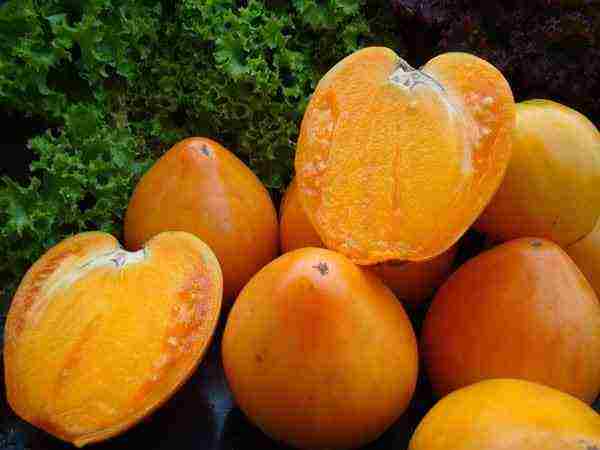
Sweet yellow tomatoes
Polycarbonate greenhouse tomato varieties
Compared to outdoor cultivation, indoor tomatoes grow larger and healthier. The fact is that suitable climatic conditions are created here:
- dosed sunlight;
- optimal air humidity;
- lack of wind streams;
- temperature changes are less sensitive.
When choosing varieties for a greenhouse, pay attention to large-fruited, sweet, productive, late blight-resistant tomatoes.
Late blight-resistant tomatoes
Natural resistance to this common disease is much preferable to multiple chemical treatments. Hybrids and original seeds, which mature in 70-90 days, are optimal for areas prone to late blight.
"Dubrava", "grotto", "gay", "cameo", "profitable", "budenovka", "lights of Moscow", "berry", "fighter", "blizzard" - the best varieties of tomatoes for greenhouses, tolerant to late blight wilting and other diseases.
Unlimited in growth "Eupator F1" has gained popularity due to its unique properties. Vegetable growers can really appreciate the variety for its yield and resistance to most "tomato" diseases, including late blight. The nightshade crop in polycarbonate greenhouses grows very well, but varietal characteristics should be taken into account:
- seedlings are best acclimatized if they are planted at the age of 45 days;
- the garter of the hybrid should be carried out as early as possible, but after the engraftment period;
- the bush is formed into one stem;
- stepsons must be removed in a timely manner.
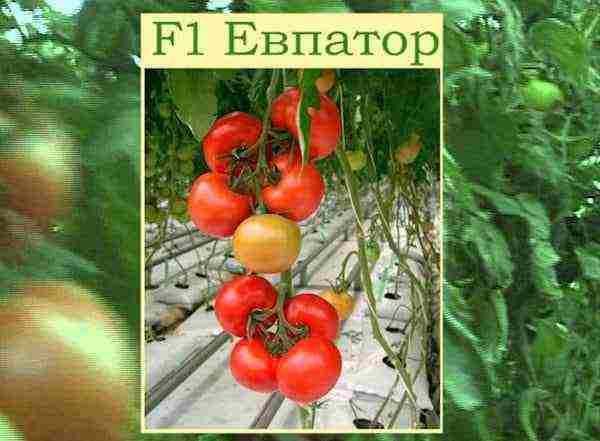
"Evpator F1"
The famous "de barao", successfully grown in the middle lane and in the suburbs, despite the ripening period - up to 130 days, is also resistant to late blight wilt. To get a harvest on a par with rapidly maturing species, seeds are sown for seedlings two weeks earlier than the standard first crops - in February.
Cherry tomatoes and large fruits
According to reviews, one of the best varieties that mature in 90 days is the "Thumbelina". The original variety grows in an indeterminate manner. A polycarbonate greenhouse is the best option for growing and ripening 15-20 grams of fruit. One brush can contain up to 15 medium-sized tomatoes. Trellises will not interfere with growth. The grape-shaped "Thumbelina" is recommended for fresh consumption and has a moderate sweetness.
Farmers often call the “sweet bunch” the best variety for the Moscow region. Glossy fruits have time to fully ripen in three months. The short ripening period practically does not depend on temperature changes, but the “sweet bunch” is grown only in protected ground conditions. The cultivar is resistant to most of the traditional nightshade diseases.
Large-fruited tomatoes, as a rule, guarantee a high yield. The name "pudovik" speaks for itself. The seed producer guarantees a yield of 5 kg per bush. At the same time, caring for the plant does not require experience: the recommendations for growing are standard for semi-determinant tomatoes. The best indicators for the collection of vegetables are characteristic of a two-three-stemmed bush. Another possible name for the original "pudovik" is "stellate sturgeon".
According to the reviews of farmers from the North-West region, greenhouse tomato varieties with good performance under proper cultivation conditions show "rainbow" and "rank". The five kilogram "rank" plum-like fruit can be harvested from one bush by putting it in two stalks. The height of the plant is up to a meter, but additional support in the form of trellises will not hurt. Ripe "raja" - dark red, sweet, juicy.
The fruits of "rainbow" are often called gigantic, although the selection indicators are kept within 330-370 grams. The vegetable does not grow smaller with each new stage of ripening. An amber yellow color indicates that the tomato is ready to eat. Many sow rainbow seeds for seedlings from year to year. It is not surprising: at first the tomato attracts with its appearance, upon closer acquaintance - with its internal content.
Early ripening varieties of greenhouse tomatoes
Early maturity, as one of the main advantages when choosing, must be taken into account. Early fruiting allows you not only to quickly acquire tasty vegetables, but also to avoid certain diseases (for example, phytophthora). The best early tomatoes include those that mature in up to 100 days.
The color of the tangerine tomato lives up to its name. The weight of the vegetable is standard - about 100 grams. An adult plant is weakly susceptible to diseases such as cladosporium and fusarium. Ripe fruits have high tasting ratings. Even in stressful situations, typical for risky farming zones, "mandarin duck" ripens perfectly. Tomatoes are forming on the brush. The plant loves artificial support.
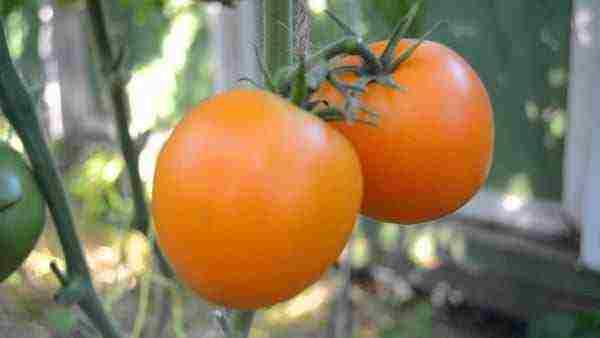
Attractive "Mandarin"
Super early species mature in two and a half months.As a rule, such tomatoes are medium-sized, but "Sultan F1" refers to large-fruited. Dutch breeders worked on this new variety for a different climatic zone, but the hybrid showed itself well in the Moscow region. Vegetable growers process tomatoes for juice, and also actively use them fresh. "Sultan F1" matures in 70 days.
In 90 days after germination, the fruits are removed from the plants of the "Nevsky" variety. The best indicators are typical for areas of the Moscow region. The variety is unpretentious, readily responds to nitrogen fertilization at the transplant stage. A mature vegetable is bright red, but you need to remove it before maturity, when the fruit acquires a pinkish tint.
High-yielding tomatoes
The best high-yielding greenhouse tomato varieties are worth looking for in the indeterminants. These include "ivyngo F1". It is appreciated not only for its yield, but also for its tolerance to care. Although it is difficult to call a greenhouse hybrid unpretentious, but "ivyngo F1" refers precisely to those. With proper care, up to ten kilograms are removed from one square meter. The vegetable has a slight attractive ribbing.
Another high-yielding variety that develops according to the indeterminate type is the F1 melody. For 70-80 days, bright red tomatoes ripen on the branches, the average weight of which ranges from 200-250 grams. The hybrid is not unpretentious, it will require timely picks, dressings, undercuts and garters.
The main advantage of "perfect saw F1" is its resistance to fusarium wilting, resistance to gray and bacterial leaf spot, as well as to alternaria stem cancer. It belongs to the early varieties. The best way to grow is under polycarbonate protection. Due to its small size, Perfect Peel F1 can be easily preserved as a whole. Farmers note the high viscosity of ripe fruits: dry substances abound in the composition.
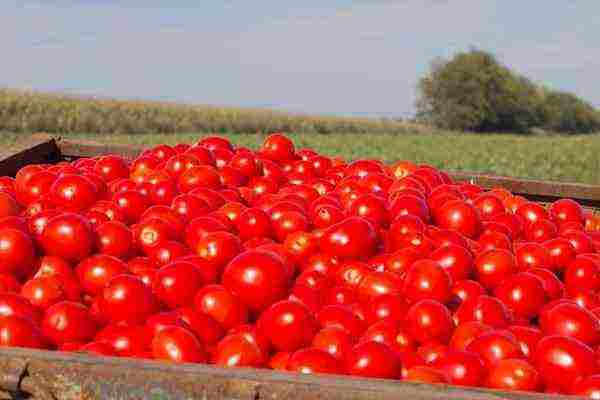
Perfectpil F1 is one of the best in the harvest
Red and pink tomatoes
Tomatoes of unusual color are in demand among experienced vegetable growers. Often, raspberry varieties are characterized by increased sweetness and meatiness, which is why they are more expensive on the market. Paradise Delight and Fenda F1 are the best varieties of polycarbonate greenhouse tomatoes. The ripe fruit of "heavenly delight" is scarlet with a slight ribbing. Most vegetables ripen when the plant is put in one stem. A loose planting is compensated by a yield from one bush - up to eight kilograms.
Tomato "Fenda F1", due to its resistance to temperature extremes, can be grown in open areas, however, the largest and sweetest fruits can be harvested only in polycarbonate greenhouses. The growing hybrid is supportive of phosphorus fertilization. During the adaptation stage and before flowering, it is recommended to introduce nitrogen. When flowers appear, phosphorus and potassium come to the fore. With proper care, up to 10 brushes are formed on the plant.
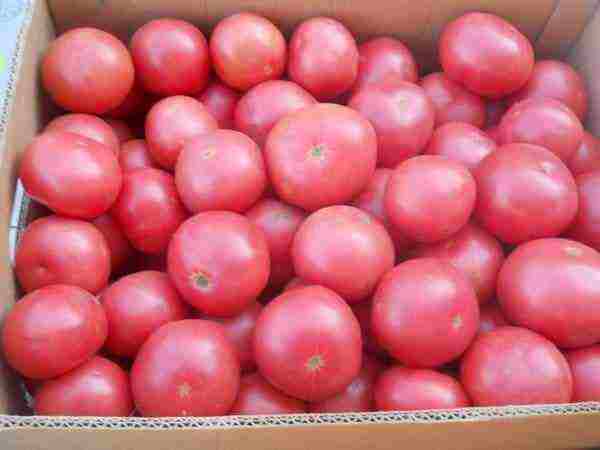
Pink varieties
Hybrid tomato varieties for the greenhouse
Given the peculiarities of the northern regions of the country, it is difficult to choose which varieties of tomatoes are best planted in a polycarbonate greenhouse in order to get a good harvest. In protected conditions, the "pudovik", "sugar bison", "alsu" proved themselves worthy. At the same time, among the plants with a short ripening period, early maturing, early maturing and ultra early maturing varieties are distinguished. Kostroma F1, Ural F1, Intuition F1, Niagara F1 are the best hybrids.
Each manufacturer advertises its product from the best side, deliberately omitting the specific characteristics of the variety. Therefore, it is best to rely on familiar species, and take new seeds in limited quantities for experiments.
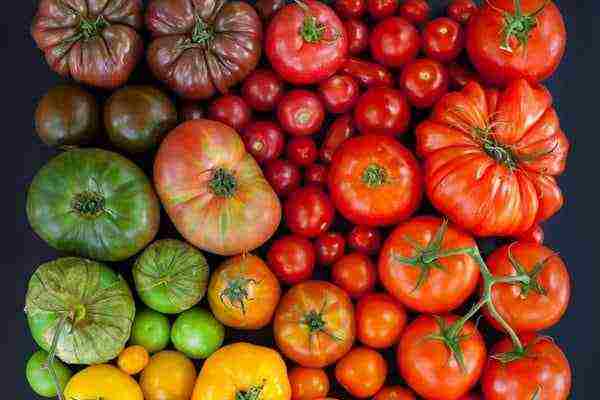
Variety of tomatoes
For the middle lane, it is recommended to plant tasty and early ripening hybrids - "Sharp F1", "Commissioner F1", "Master F1", "Ereme F1". Also suitable: "Navigator F1", "Lubava F1", "Flute F1", "Manechka F1".Growing nightshades from original seeds is considered risky, but it is the non-hybrid varieties that keep valuable qualities from generation to generation. It is easy to develop your own methodology with "honey spas", "mushroom basket", "scarlet sails", since these seeds are stable on the shelves from year to year.
Video: how to choose varieties of tomatoes for a greenhouse
Summer residents filmed many interesting videos with personal experience on choosing the best variety of tomatoes for greenhouses. However, do not forget to take into account the peculiarities of zoning.
Video: Choosing a tomato variety
Video: Overview of the most productive hybrids
Video: Large-fruited tomatoes
A sustainable greenhouse crop is the sum of many things. These should include:
- seed quality;
- suitable soil mixture composition;
- preparation of the greenhouse before planting;
- disinfection of soil at important stages of plant development (planting, transplanting, planting);
- timely and suitable feeding;
- protection from potential pests;
- watering.
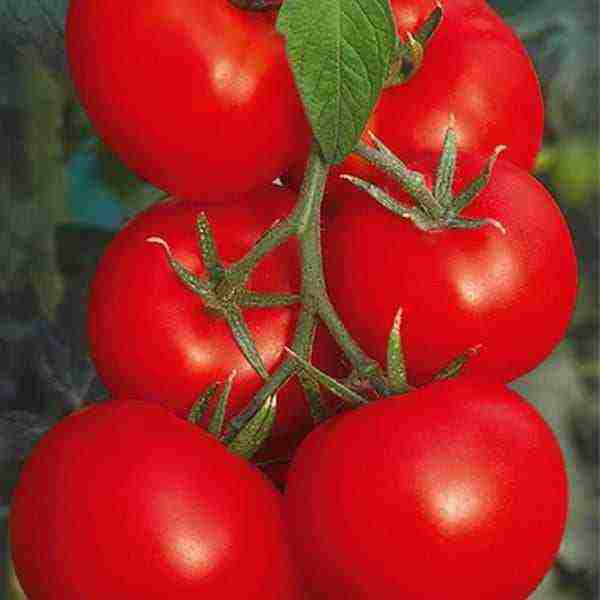
Rock and Roll F1
Greenhouse vegetables are considered healthier than ground vegetables. Special growing conditions help to achieve a higher concentration of nutrients (including those that fight cancer cells), vitamin C. Many varieties of greenhouse tomatoes are not treated against pests, as they are naturally resistant to diseases.
